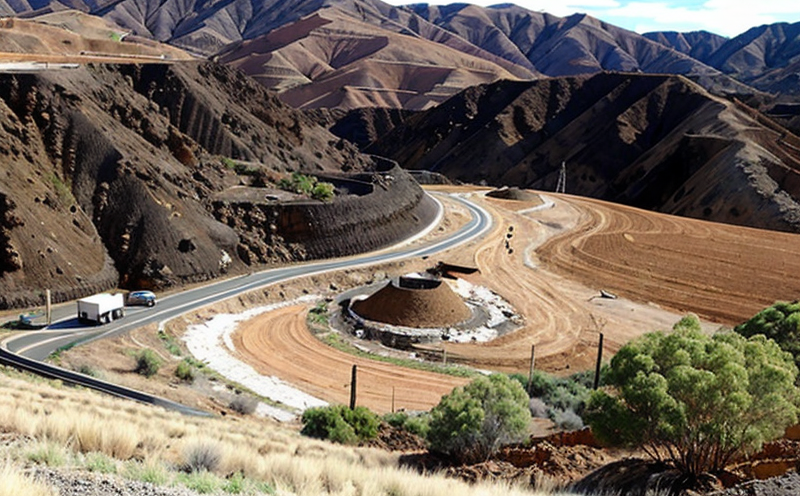EN 13657 Aqua Regia Digestion of Rehabilitated Soil Testing
The European Standard EN 13657 outlines a specific method for the digestion of rehabilitated soil using aqua regia. This procedure is crucial in assessing the effectiveness and long-term stability of mine rehabilitation efforts, ensuring that reclaimed land meets stringent environmental standards.
The process involves digesting a representative sample of soil using a mixture of concentrated nitric acid (HNO₃) and hydrochloric acid (HCl). The use of aqua regia in this context is not merely for chemical analysis but also serves as an indicator of the residual contaminants that may persist after reclamation. This method helps determine whether the rehabilitated soil has been adequately treated to ensure it meets the ecological requirements set forth by regulatory bodies.
The test parameters are meticulously defined, ensuring accuracy and reliability in the results. Soil samples must be prepared carefully according to standard procedures before undergoing digestion. The digestion process itself is carried out at specific temperatures and durations to optimize the extraction of metals and other potential contaminants. Post-digestion, the solutions are analyzed using atomic absorption spectroscopy (AAS), inductively coupled plasma mass spectrometry (ICP-MS), or other suitable analytical techniques.
The results of this test are critical for quality managers, compliance officers, and R&D engineers within mining sectors. It provides a quantitative measure of the success of reclamation efforts by quantifying the presence of metals that may otherwise hinder plant growth or pose risks to wildlife. The findings can also guide future rehabilitation strategies, ensuring that best practices are continuously improved.
Compliance officers will find this test particularly valuable as it helps in meeting regulatory requirements set forth by international standards such as EN 13657 and other relevant guidelines. By using this method, mining companies can demonstrate their commitment to environmental sustainability and long-term land rehabilitation.
R&D engineers benefit from this testing process by gaining insights into the effectiveness of different reclamation techniques and materials used in soil remediation. This information is invaluable for developing new technologies and methodologies that can enhance the reclamation process, making it more efficient and cost-effective.
For procurement professionals, understanding the parameters of EN 13657 aids in selecting suppliers who adhere to high standards of environmental responsibility. It ensures that only materials and processes that meet strict quality benchmarks are used in rehabilitation projects.
- Sample Preparation: Careful selection and preparation of soil samples to ensure representativeness.
- Digestion Process: Standardized digestion using aqua regia, followed by precise temperature control.
- Analytical Methods: Use of advanced analytical techniques for accurate quantification of metals and other contaminants.
Why It Matters
The significance of EN 13657 cannot be overstated in the context of environmental restoration projects. By ensuring that rehabilitated soil is free from harmful contaminants, this method plays a pivotal role in supporting sustainable land use practices.
Mine rehabilitation and land restoration are essential components of responsible mining operations. The process involves not only reclaiming land but also making it suitable for future ecological and agricultural purposes. Using EN 13657 ensures that the reclaimed soil is safe for reintegration into natural ecosystems, promoting biodiversity and supporting local communities.
The test results are particularly important because they provide a scientific basis for decision-making in post-mining land use planning. By identifying any residual contaminants, this method helps to mitigate risks associated with land misuse or future reclamation efforts. This is crucial not only from an environmental standpoint but also for the economic viability of mining operations.
The findings can inform the development of best practices and standards for mine rehabilitation, ensuring that future projects are conducted in a manner that minimizes environmental impact. Additionally, it supports compliance with international standards and local regulations, thereby enhancing the reputation and credibility of mining companies.
Benefits
- Educational Value: Provides insights into the effectiveness of soil rehabilitation techniques.
- Regulatory Compliance: Ensures that reclamation efforts meet strict environmental standards.
- Sustainable Practices: Supports long-term land use planning and ecological restoration.
- Economic Viability: Helps in reducing risks associated with land misuse or future reclamation efforts.
- Reputation Enhancement: Demonstrates a commitment to environmental responsibility, enhancing the company’s reputation.
Environmental and Sustainability Contributions
The implementation of EN 13657 Aqua Regia Digestion in soil testing contributes significantly to environmental sustainability. By ensuring that rehabilitated land is free from harmful contaminants, this method facilitates the reintegration of reclaimed areas into natural ecosystems. This not only promotes biodiversity but also supports local communities by providing opportunities for sustainable agriculture and other land uses.
The test results are instrumental in informing decisions about post-mining land use planning. They provide a scientific basis for determining which areas can be safely reintegrated into the environment, thereby minimizing risks associated with land misuse or future reclamation efforts. This contributes to reducing the ecological footprint of mining operations and promoting sustainable development.
The findings from this method also help in developing best practices and standards for mine rehabilitation. By continuously improving these processes, mining companies can ensure that their operations have a minimal impact on the environment while still being economically viable. This aligns with broader sustainability goals aimed at reducing carbon footprints and promoting circular economy principles.
Moreover, the use of EN 13657 supports compliance with international standards such as ISO 14001, which focuses on environmental management systems. By adhering to these standards, mining companies can demonstrate their commitment to environmental responsibility and long-term sustainability.





